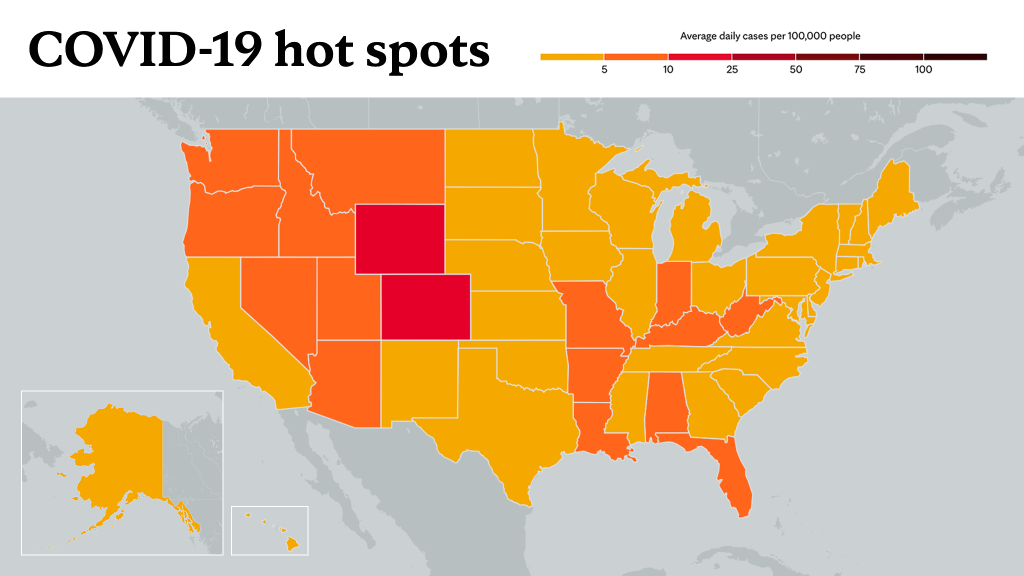
ROCHESTER, Minn. — Artificial intelligence (AI) may offer a way to accurately determine that a person is not infected with COVID-19. An international retrospective study finds that infection with SARS-CoV-2, the virus that causes COVID-19, creates subtle electrical changes in the heart. An AI-enhanced EKG can detect these changes and potentially be used as a rapid, reliable COVID-19 screening test to rule out COVID-19 infection.
The AI-enhanced EKG was able to detect COVID-19 infection in the test with a positive predictive value ― people infected ― of 37% and a negative predictive value ― people not infected ― of 91%. When additional normal control subjects were added to reflect a 5% prevalence of COVID-19 — similar to a real-world population — the negative predictive value jumped to 99.2%. The findings are published in Mayo Clinic Proceedings.
COVID-19 has a 10- to 14-day incubation period, which is long compared to other common viruses. Many people do not show symptoms of infection, and they could unknowingly put others at risk. Also, the turnaround time and clinical resources needed for current testing methods are substantial, and access can be a problem.
"If validated prospectively using smartphone electrodes, this will make it even simpler to diagnose COVID infection, highlighting what might be done with international collaborations," says Paul Friedman, M.D., chair of Mayo Clinic's Department of Cardiovascular Medicine in Rochester. Dr. Friedman is senior author of the study.
The realization of a global health crisis brought together stakeholders around the world to develop a tool that could address the need to rapidly, noninvasively and cost-effectively rule out the presence of acute COVID-19 infection. The study, which included data from racially diverse populations, was conducted through a global volunteer consortium spanning four continents and 14 countries.
"The lessons from this global working group showed what is feasible, and the need pushed members in industry and academia to partner in solving the complex questions of how to gather and transfer data from multiple centers with their own EKG systems, electronic health records and variable access to their own data," says Suraj Kapa, M.D., a cardiac electrophysiologist at Mayo Clinic. "The relationships and data processing frameworks refined through this collaboration can support the development and validation of new algorithms in the future."
The researchers selected patients with EKG data from around the time their COVID-19 diagnosis was confirmed by a genetic test for the SARS-Co-V-2 virus. These data were control-matched with similar EKG data from patients who were not infected with COVID-19.
Researchers used more than 26,000 of the EKGs to train the AI and nearly 4,000 others to validate its readings. Finally, the AI was tested on 7,870 EKGs not previously used. In each of these sets, the prevalence of COVID-19 was around 33%.
To accurately reflect a real-world population, more than 50,000 additional normal EKGs were then added to reach a 5% prevalence rate of COVID-19. This raised the negative predictive value of the AI from 91% to 99.2%.
Zachi Attia, Ph.D., a Mayo Clinic engineer in the Department of Cardiovascular Medicine, explains that prevalence is a variable in the calculation of positive and negative predictive values. Specifically, as the prevalence decreases, the negative predictive value increases. Dr. Attia is co-first author of the study with Dr. Kapa.
"Accuracy is one of the biggest hurdles in determining the value of any test for COVID-19," says Dr. Attia. "Not only do we need to know the sensitivity and specificity of the test, but also the prevalence of the disease. Adding the extra control EKG data was critical to demonstrating how a variable prevalence of the disease ― as we have encountered with regions having widely different rates of disease at different stages of the pandemic ― would impact how the test would perform."
"This study demonstrates the presence of a biological signal in the EKG consistent with COVID-19 infection, but it included many ill patients. While it is a hopeful signal, we must prospectively test this in asymptomatic people using smartphone-based electrodes to confirm that it can be practically used in the fight against the pandemic," notes Dr. Friedman. "Studies are underway now to address that question."
About this study
This study was designed and conceived by Mayo Clinic investigators, and the work was made possible in part by a philanthropic gift from the Lerer Family Charitable Foundation Inc., and by the voluntary support from participating physicians and hospitals around the world who contributed in an effort to combat the COVID-19 pandemic. Technical support was donated by GE Healthcare, Philips and Epiphany Healthcare for the transfer of EKG data.
###
About Mayo Clinic
Mayo Clinic is a nonprofit organization committed to innovation in clinical practice, education and research, and providing compassion, expertise and answers to everyone who needs healing. Visit the Mayo Clinic News Network for additional Mayo Clinic news. For information on COVID-19, including Mayo Clinic's Coronavirus Map tracking tool, which has 14-day forecasting on COVID-19 trends, visit the Mayo Clinic COVID-19 Resource Center.
Media contact:
- Terri Malloy, Mayo Clinic Public Affairs, newsbureau@mayo.edu
__________________________________________________________
Information in this post was accurate at the time of its posting. Due to the fluid nature of the COVID-19 pandemic, scientific understanding, along with guidelines and recommendations, may have changed since the original publication date.
For more information and all your COVID-19 coverage, go to the
Mayo Clinic News Network and mayoclinic.org.
Learn more about tracking COVID-19 and COVID-19 trends.








